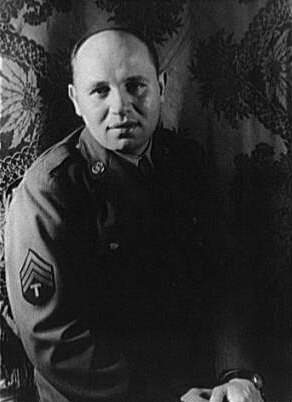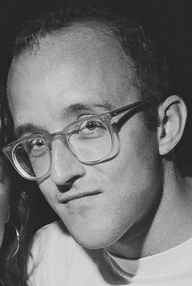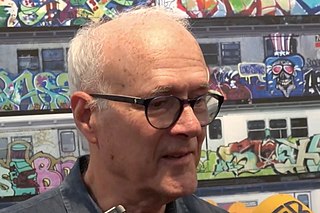
James De La Vega (1972) is a visual artist of Puerto Rican descent who lives in New York City. He is best known for his street aphorisms and muralist art. [1]

James De La Vega (1972) is a visual artist of Puerto Rican descent who lives in New York City. He is best known for his street aphorisms and muralist art. [1]
James De La Vega was born in East Harlem, the son of Jaime De La Vega and Elsie Matos, and graduated valedictorian [2] at York Preparatory School and attended Cornell University, where he graduated in 1994 with a Bachelor of Fine Arts. He is a former art teacher at York Preparatory School. [3]
In 2003 De La Vega failed to win a primary for New York State senate while campaigning on healthcare access for Spanish Harlem residents. [4] There have been difficult times for De La Vega. He got sick, and when his mother died, he lost his storage where he had merchandise, paintings, and many other items. His attitude has always been to keep going and continue his work. [5]
He was featured as a live action character in the backdoor pilot "Postcards from Buster" from the animated series Arthur , as "Dr. De La Vega" while Arthur and Buster toured New York City with their camcorder.
De La Vega is known as a community-inspiring artist. Those who come across his work know him primarily for his murals and sidewalk chalk drawings. His murals can be found mostly in East Harlem, and his chalk drawings may show up anywhere in Manhattan. His street drawings are usually accompanied by aphoristic messages such as "Become Your Dream." Legally, his outdoor work qualifies as graffiti, although many put them in a separate genre. James De La Vega was a recipient of a Joan Mitchell Foundation Painters & Sculptors Grant in 1999.
De La Vega was featured in MoMA PS1 Exhibit 100 Drawings in the spring of 1999 alongside other prominent contemporary artist such as Danica Phelps, Rob Pruitt, Amy Gartrell and Olav Westphalen. [6]
Christie's auction house has featured some of his work, and fans were able to view his more intimate work in his East Village gallery until the location closed in 2010. [1] [7] [8]
In 2011, De La Vega collaborated with Tory Burch to create a line of accessories that benefited the Tory Burch Foundation. [9]
Beloved in Spanish Harlem for his public murals, artist De La Vega quietly disappeared from the art scene in 2012 following a cancer diagnosis and subsequent treatment. On September 28, 2023, the Dynamic Arts Gallery in the Bronx will present a new exhibit titled “De La Vega Museum.” The Gallery is located at 770 Castle Hill Ave, Bronx, and there will be an opening reception from 5-8:00 pm. The exhibition will continue until November 7. [10]
In July 2003, De La Vega was charged with vandalism for a mural he painted on a blank wall in the Bronx. He was offered one year's probation in exchange for a guilty plea, but he refused to say he caused “damage” to the property and thus sentenced to 50 hours of community service. [11] [7]
In May 2014, artist De La Vega filed a cease-and-desist letter to Apple, claiming their new ad campaign for the iPhone 5S uses his trademarked slogan, “You are more powerful than you think”. [12] Apple's usage of the slogan 'clearly misleads customers into believing De La Vega somehow supports, approves and/or endorses its products' it apparently adds. [13]

Charles Henry Alston was an American painter, sculptor, illustrator, muralist and teacher who lived and worked in the New York City neighborhood of Harlem. Alston was active in the Harlem Renaissance; Alston was the first African-American supervisor for the Works Progress Administration's Federal Art Project. Alston designed and painted murals at the Harlem Hospital and the Golden State Mutual Life Insurance Building. In 1990, Alston's bust of Martin Luther King Jr. became the first image of an African American displayed at the White House.

Romare Bearden was an American artist, author, and songwriter. He worked with many types of media including cartoons, oils, and collages. Born in Charlotte, North Carolina, Bearden grew up in New York City and Pittsburgh, Pennsylvania, and graduated from New York University in 1935.

David Alfaro Siqueiros was a Mexican social realist painter, best known for his large public murals using the latest in equipment, materials and technique. Along with Diego Rivera and José Clemente Orozco, he was one of the most famous of the "Mexican muralists".

Keith Allen Haring was an American artist whose pop art emerged from the New York City graffiti subculture of the 1980s. His animated imagery has "become a widely recognized visual language". Much of his work includes sexual allusions that turned into social activism by using the images to advocate for safe sex and AIDS awareness. In addition to solo gallery exhibitions, he participated in renowned national and international group shows such as documenta in Kassel, the Whitney Biennial in New York, the São Paulo Biennial, and the Venice Biennale. The Whitney Museum held a retrospective of his art in 1997.

Ben Shahn was an American artist. He is best known for his works of social realism, his left-wing political views, and his series of lectures published as The Shape of Content.

José Luis Cuevas was a Mexican artist, he often worked as a painter, writer, draftsman, engraver, illustrator, and printmaker. Cuevas was one of the first to challenge the then dominant Mexican muralism movement as a prominent member of the Generación de la Ruptura. He was a mostly self-taught artist, whose styles and influences are moored to the darker side of life, often depicting distorted figures and the debasement of humanity. He had remained a controversial figure throughout his career, not only for his often shocking images, but also for his opposition to writers and artists who he feels participate in corruption or create only for money. In 1992, the José Luis Cuevas Museum was opened in the historic center of Mexico City holding most of his work and his personal art collection. His grandson Alexis de Chaunac is a contemporary artist.

Aaron Douglas was an American painter, illustrator and visual arts educator. He was a major figure in the Harlem Renaissance. He developed his art career painting murals and creating illustrations that addressed social issues around race and segregation in the United States by utilizing African-centric imagery. Douglas set the stage for young, African-American artists to enter the public-arts realm through his involvement with the Harlem Artists Guild. In 1944, he concluded his art career by founding the Art Department at Fisk University in Nashville, Tennessee. He taught visual art classes at Fisk until his retirement in 1966. Douglas is known as a prominent leader in modern African-American art whose work influenced artists for years to come.

Henry Chalfant is an American photographer and videographer most notable for his work on graffiti, breakdance, and hip hop culture.
Bernard Lamotte was a Paris-born artist, illustrator, painter, and muralist. He attended the École des Beaux-Arts at the Sorbonne and studied under Bernand Corman and Lucien Simon (1861–1945). From 1932 to 1935, he traveled to Tahiti and New York and in 1935 he moved to New York City to pursue his art.

Hale Aspacio Woodruff was an American artist known for his murals, paintings, and prints.
Louis Jessup Delsarte III was an African-American artist known for what has sometimes been called his "illusionistic" style. He was a painter, muralist, printmaker, and illustrator.

Mexican muralism refers to the art project initially funded by the Mexican government in the immediate wake of the Mexican Revolution (1910-1920) to depict visions of Mexico's past, present, and future, transforming the walls of many public buildings into didactic scenes designed to reshape Mexicans' understanding of the nation's history. The murals, large artworks painted onto the walls themselves had social, political, and historical messages. Beginning in the 1920s, the muralist project was headed by a group of artists known as "The Big Three" or "The Three Greats". This group was composed of Diego Rivera, José Clemente Orozco and David Alfaro Siqueiros. Although not as prominent as the Big Three, women also created murals in Mexico. From the 1920s to the 1970s, murals with nationalistic, social and political messages were created in many public settings such as chapels, schools, government buildings, and much more. The popularity of the Mexican muralist project started a tradition which continues to this day in Mexico; a tradition that has had a significant impact in other parts of the Americas, including the United States, where it served as inspiration for the Chicano art movement.
Manny Vega is an American painter, illustrator, printmaker, muralist, mosaicist, and set and costume designer. His work portrays the history and traditions of the African Diaspora that exist in the United States, the Caribbean, and Latin America.
Whitfield Lovell is a contemporary African-American artist who is known primarily for his drawings of African-American individuals from the first half of the 20th century. Lovell creates these drawings in pencil, oil stick, or charcoal on paper, wood, or directly on walls. In his most recent work, these drawings are paired with found objects that Lovell collects at flea markets and antique shops.
Daniel Manrique was a Mexican artist whose life and work mostly revolved around his home neighborhood of Tepito in Mexico City. He was born into a poor family, who did not support his artistic ambitions, but he maintained his Tepito identity despite. Manrique is best known for his mural work, which depicts the life and popular culture of poor urban neighborhoods such as Tepito, as well as aspects of Mexican and Latin American history since the Spanish conquest. Most of this work was done in Tepito as part of the program he founded called Tepito Arte Acá, but he also did murals in other countries such as Canada and Argentina. His work and the work of Tepito Arte Acá has been recognized by UNESCO, several universities, the Museo de Arte Moderno, CONACULTA, INBA and he was accepted into the Salón de la Plástica Mexicana.

Zapata (1932) is a lithograph by the Mexican artist Diego Rivera (1886–1957) that depicts the Mexican revolutionary Emiliano Zapata (1879–1919) as he holds the reins of a horse among a group of campesinos (peasants). The lithographic edition was created and printed twelve years after Zapata's assassination. Zapata is based on Agrarian Leader Zapata (1931), one of eight "portable" frescoes produced explicitly for Rivera's solo exhibition at the Museum of Modern Art (MoMA) in 1931, which was adapted from his previous Revolt panel from a fresco titled The History of Cuernavaca and Morelos (1929–30) painted in the Palace of Cortés, Cuernavaca. There were 100 original prints of the lithograph, many of which are in the collections of various art museums.

Candida Alvarez is an American artist and professor, known for her paintings and drawings.
Calvin Bell Jones was an afrocentric visual artist and a Black Arts Movement activist from Chicago. He is known primarily for his nine murals and paintings.

Janet Henry is a visual artist based in New York City.

RABI is a first generation American visual artist of Puerto Rican and Polish descent from Los Angeles, California. He is known for being part of the artist collective, CYRCLE. RABI's works can be seen in public and private collections including that of Shepard Fairey, Ari Emanuel, Sean Combs, Museo de Arte Contemporáneo de Puerto Rico, MOCA Detroit, Bishop Museum in Hawaii, MGM Grand in Las Vegas, The Art of Elysium, and the Contemporary Art Center in New Orleans.